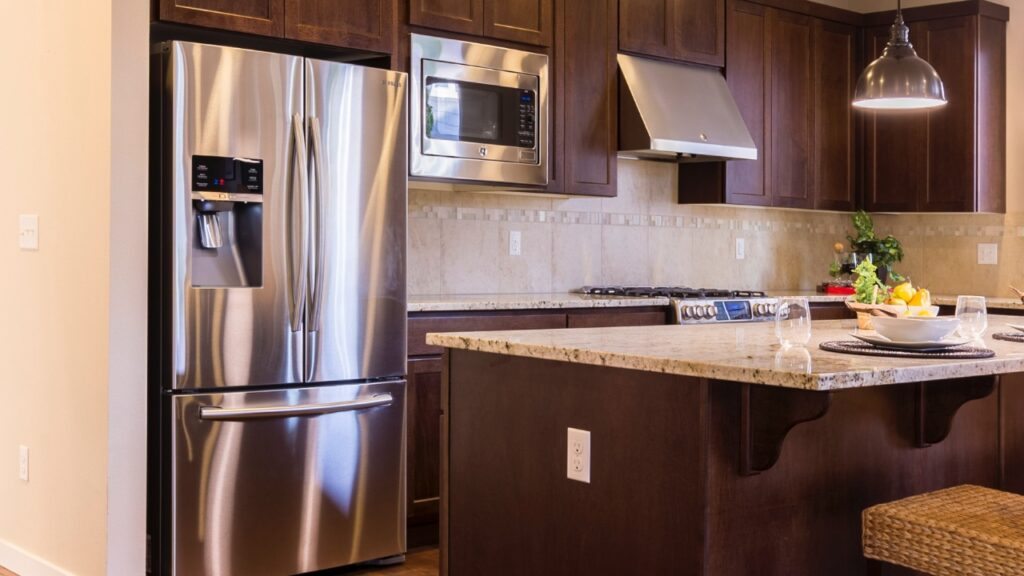Cleaning a refrigerator water dispenser is crucial to ensure the water remains fresh and free from any contaminants that might affect its taste or quality. It is a good idea to keep the kitchen appliances not only looking clean, but actually clean. Here’s a comprehensive guide to cleaning your refrigerator water dispenser.
Why Clean the Water Dispenser?
Regular use of a water dispenser can lead to mineral deposits, bacterial growth, or mold buildup, affecting the taste and quality of the water. Cleaning the dispenser prevents these issues, ensuring clean and safe drinking water.
How Often Do You Need to Clean the Water Dispenser in the Refrigerator?
The frequency of cleaning your refrigerator water dispenser depends on various factors, including usage, water quality, and environmental conditions. However, a general guideline for maintaining cleanliness is to clean the water dispenser approximately every 2 to 3 months.
Here are some considerations to help determine the cleaning frequency:
Usage:
- High Usage: If your water dispenser sees heavy daily use, it’s advisable to clean it more frequently, potentially every 1 to 2 months.
- Low Usage: For less frequent use, such as in secondary refrigerators or in homes where the water dispenser isn’t used often, cleaning every 3 to 4 months might suffice.
Water Quality:
- Quality of Water Source: If your water supply tends to have more minerals or sediments, there might be a higher chance of mineral deposits building up in the dispenser. Consider cleaning more frequently in such cases.
Environmental Factors:
- Humidity: High humidity environments can encourage mold or bacterial growth. If your kitchen or the area around the refrigerator is consistently humid, more frequent cleaning may be necessary.
- Temperature: Fluctuations in temperature can contribute to condensation, potentially leading to moisture buildup and mold growth. Consider cleaning more often in environments with significant temperature variations.
Signs that Indicate Cleaning Is Needed:
- Odor or Taste: If you notice an unusual taste or odor in the water, it’s a clear sign that the dispenser needs cleaning.
- Visible Buildup: Inspect the dispenser periodically for any visible signs of mineral deposits, mold, or discoloration.
How to Clean the Refrigerator Water Dispenser
Tools and Materials Needed:
- Vinegar or Lemon Juice: These natural acids help dissolve mineral deposits.
- Warm Water: Use for rinsing and diluting cleaning solutions.
- Soft Cloth or Sponge: To wipe surfaces without scratching.
- Toothbrush or Small Cleaning Brush: Ideal for reaching small or narrow areas.
- Sanitizing Solution (Optional): For added disinfection, use a food-safe sanitizer.
- Towels or Paper Towels: For drying surfaces after cleaning.
- Owner’s Manual: Refer to the manufacturer’s instructions for specific guidance on your refrigerator model.
Step-by-Step Cleaning Process:
1. Preparation:
- Turn Off the Water Supply: Locate and turn off the water supply to the dispenser. This prevents accidental spills and ensures safety during cleaning.
- Empty the Dispenser: Remove any remaining water from the dispenser by dispensing it or using a towel to soak it up.
2. Remove and Clean Components:
- Drip Tray and Grille: Remove the drip tray and grille if they’re detachable. Wash these components with warm, soapy water. If there are stubborn stains like mold, use a mixture of mild detergent and warm water to soak and clean these parts thoroughly.
- Dispenser Nozzle or Spout: Detach the nozzle or spout according to the manufacturer’s instructions. Soak it in a solution of warm water and vinegar or lemon juice to dissolve any mineral deposits. Use a brush to scrub away residue and rinse thoroughly.
3. Clean Exterior Surfaces:
- Exterior of the Dispenser: Wipe down the external surfaces of the dispenser with a soft cloth dampened with a mild detergent solution. Be cautious around control panels or electronic components—avoid excessive moisture.
4. Interior Cleaning:
- Interior Surfaces: Use a mixture of warm water and vinegar or lemon juice to clean the inside of the dispenser. Dip a cloth or sponge into this solution and wipe the interior surfaces thoroughly, paying attention to areas prone to buildup.
- Rinsing: After cleaning, rinse the interior with clean, warm water to remove any cleaning solution residue.
- Sanitizing (Optional): For added disinfection, use a food-safe sanitizer diluted according to the manufacturer’s instructions. Wipe the interior surfaces and let them air dry.
5. Reassemble and Test:
- Reassemble Components: Once all parts are clean and dry, reattach the components according to the manufacturer’s instructions.
- Turn On the Water Supply: Restore the water supply and allow water to run through the system for a few minutes to flush out any remaining cleaning solution.
- Test the Dispenser: Dispense water and check for any unusual taste or odor. If there’s still an off-putting flavor, run more water through the system until it tastes clean.
6. Regular Maintenance:
- Frequency: Aim to clean the water dispenser every 2-3 months to maintain optimal cleanliness and water quality.
- Monitoring: Regularly check for any signs of buildup or contamination. Wipe spills promptly to prevent stains or mold growth.
Safety Precautions:
- Unplug the Refrigerator: For added safety, consider unplugging the refrigerator before starting the cleaning process.
- Wear Gloves: If handling strong cleaning solutions, wear protective gloves to protect your skin.
Additional Tips:
- Avoid Harsh Cleaners: Avoid using abrasive cleaners or harsh chemicals as they may damage the surfaces or leave residues.
- Follow Manufacturer’s Guidelines: Always refer to the manufacturer’s instructions for specific cleaning recommendations for your refrigerator model.
By following these steps, you can ensure a clean and well-maintained refrigerator water dispenser, providing you and your family with safe and fresh drinking water. Remember, regular cleaning not only maintains water quality but also prolongs the life of your appliance.


